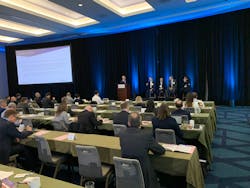Moderator: Stephen G. Anderson, Director, Industry Development, SPIE
Panelists:
- Giovanni Barbarossa, Ph.D., Chief Strategy Officer, II-VI Inc., and President, Compound Semiconductors
- Ralf Kimmel, General Manager, Trumpf Inc.
- David Nislick, Ph.D., CEO, Excelitas Technologies
- Kurt Weingarten, Ph.D., General Partner, Tarkas Ventures
Steve Anderson, who marked his 35th anniversary at this show, asked the panelists first for current challenges in the photonics marketplace (see figure). Giovanni Barbarossa immediately pointed to the problem of hiring talent. It turned out that this is a multifaceted problem.
On the one hand, it is about lack of staff on the technician level. This problem has been persistent over many years. Ralf Kimmel explained the approach Trumpf is establishing in America: Supported by the German American Chamber of Commerce, they initiated education programs and apprenticeships in the Midwest. They started with some 20 companies, mostly of German origin. Now, they have about 100 companies participating in the program where about 200 people graduate every year.
On the other hand, as Barbarossa emphasized, there is strong competition for talent. And it is not only coming from fancy Internet companies such as Amazon, but also from other mature industries, such as aerospace, defense, or medical technology. And this is becoming more of a problem since higher uptake of photonic solutions leads to a higher interest in photonics experts in respective industries.
David Nislick brought up another challenge in the current marketplace, namely continuing political uncertainties and the COVID-19 virus in China. He was concerned about the impact of these two factors on further consolidation in the photonics industry.
The panel agreed upon these uncertainties, even if the economic impact of the COVID-19 virus in China could not be estimated yet. So far, the effect of the lockdown in China was softened by reserves that had been made to compensate for the Chinese New Year break.
On that point, Anderson asked the panel for their expectations for market development in 2020. While any prediction seems difficult under the given constraints, the panelists were cautiously optimistic that the figures could improve this year. The downturn in the market for industrial laser equipment may have reached the bottom and could recover in 2020. Other markets, such as aerospace and defense flourish; big hopes are in consumer electronics.
Some of the trends are less obvious. Kimmel, for instance, mentioned additive manufacturing as a potential field of growth. Of course, it has been “overrated and over-invested,” as he said, “But we see demanding needs and more and more new applications coming up.”
Another unexpected trend was widely discussed: artificial intelligence (AI). It all begins with sensors and data acquisition from various processes. While this is starting on the shop floor, as Nislick confirmed, it also raises concerns about data ownership. Privacy legislation in Europe, and increasingly in the U.S., may slow down development. Kurt Weingarten sees additional advantages coming when quantum technology enters this field. This may require components and subsystems for the technical infrastructure, which is currently the subject of extensive academic efforts.
Real profits from AI may come from recurring business, as John Dexheimer from the audience extended the discussion. Innovations such as computational imaging may become interesting, and certainly, academic startups working in these fields will be the subject of acquisition interests.
To conclude the session, Anderson asked the panel for their picks of (more) interesting, but not matured applications. Kimmel came up with glass processing—that is, joining glass and metal or glass to glass with lasers. Barbarossa mentioned lasers for agriculture, while Nislick pointed to cybersecurity, where there might be an opportunity in the (hardware) supply chain. Weingarten referred to new smartphone apps that use new optical sensors for spectroscopic measurement, with the vision of a “tricorder” like device that thrills him.

